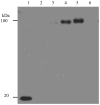Insertion of the designed helical linker led to increased expression of tf-based fusion proteins
- PMID: 19002568
- PMCID: PMC3121561
- DOI: 10.1007/s11095-008-9767-0
Insertion of the designed helical linker led to increased expression of tf-based fusion proteins
Abstract
Purpose: To demonstrate a high-level expression of transferrin (Tf)-based fusion proteins by inserting a helical linker between two protein domains.
Methods: Tf-based fusion proteins were designed to contain oligonucleotides encoding a helical linker inserted between the protein domains. Plasmid constructs were transfected into HEK293 cells and the secreted fusion proteins were purified from conditioned serum free media. Expression was assessed using both SDS-PAGE and Western Blot using anti-hGH, G-CSF, or Tf antibodies; protein bands were analyzed using Quantity One software. The function of fusion proteins consisting of human growth hormone (hGH) and Tf was evaluated in Nb2 cell proliferation assays.
Results: The fusion proteins containing a helical linker, hGH-(H4)(2)-Tf and Tf-(H4)(2)-hGH, were expressed 1.7-and 2.4-fold higher, respectively, with a twofold lower ED(50) than the hGH-Tf fusion protein without a helical linker. The Tf-(H4)(2)-G-CSF fusion protein exhibited a greater expression with an 11.2-fold increase compared with Tf-G-CSF fusion protein.
Conclusions: The helical linker introduced in Tf-fusion proteins resulted in a high-level of expression with improved in vitro bioactivity. This approach provides a simple method to increase poor expression of other fusion proteins.
Figures




Similar articles
-
Fusion protein linkers: property, design and functionality.Adv Drug Deliv Rev. 2013 Oct;65(10):1357-69. doi: 10.1016/j.addr.2012.09.039. Epub 2012 Sep 29. Adv Drug Deliv Rev. 2013. PMID: 23026637 Free PMC article. Review.
-
Human growth hormone-transferrin fusion protein for oral delivery in hypophysectomized rats.J Control Release. 2010 Jan 25;141(2):177-82. doi: 10.1016/j.jconrel.2009.09.007. Epub 2009 Sep 15. J Control Release. 2010. PMID: 19761807 Free PMC article.
-
Improving the oral efficacy of recombinant granulocyte colony-stimulating factor and transferrin fusion protein by spacer optimization.Pharm Res. 2006 Sep;23(9):2116-21. doi: 10.1007/s11095-006-9059-5. Epub 2006 Aug 9. Pharm Res. 2006. PMID: 16952003
-
Recombinant granulocyte colony-stimulating factor-transferrin fusion protein as an oral myelopoietic agent.Proc Natl Acad Sci U S A. 2005 May 17;102(20):7292-6. doi: 10.1073/pnas.0500062102. Epub 2005 May 3. Proc Natl Acad Sci U S A. 2005. PMID: 15870205 Free PMC article.
-
Design of helical linkers for fusion proteins and protein-based nanostructures.Methods Enzymol. 2021;647:209-230. doi: 10.1016/bs.mie.2020.10.003. Epub 2020 Nov 18. Methods Enzymol. 2021. PMID: 33482989 Review.
Cited by
-
In silico designing, cloning, and heterologous expression of novel chimeric human B lymphocyte CD20 extra loop.Tumour Biol. 2016 Sep;37(9):12547-12553. doi: 10.1007/s13277-016-5105-z. Epub 2016 Jun 27. Tumour Biol. 2016. PMID: 27350367
-
Fusion protein linkers: property, design and functionality.Adv Drug Deliv Rev. 2013 Oct;65(10):1357-69. doi: 10.1016/j.addr.2012.09.039. Epub 2012 Sep 29. Adv Drug Deliv Rev. 2013. PMID: 23026637 Free PMC article. Review.
-
Application of molecular dynamics simulations to design a dual-purpose oligopeptide linker sequence for fusion proteins.J Mol Model. 2018 Oct 15;24(11):313. doi: 10.1007/s00894-018-3846-x. J Mol Model. 2018. PMID: 30324504
-
Strategy of Developing Oral Vaccine Candidates Against Co-infection of Porcine Diarrhea Viruses Based on a Lactobacillus Delivery System.Front Microbiol. 2022 Apr 4;13:872550. doi: 10.3389/fmicb.2022.872550. eCollection 2022. Front Microbiol. 2022. PMID: 35444630 Free PMC article.
-
Advances and challenges in analytical characterization of biotechnology products: mass spectrometry-based approaches to study properties and behavior of protein therapeutics.Biotechnol Adv. 2012 Jan-Feb;30(1):210-22. doi: 10.1016/j.biotechadv.2011.05.006. Epub 2011 May 17. Biotechnol Adv. 2012. PMID: 21619926 Free PMC article. Review.
References
-
- Baldi L, Hacker DL, Adam M, Wurm FM. Recombinant protein production by large-scale transient gene expression in mammalian cells: state of the art and future perspectives. Biotechnol Lett. 2007;29:677–684. - PubMed
-
- Wurm F, Bernard A. Large-scale transient expression in mammalian cells for recombinant protein production. Current Opinion in Biotechnology. 1999;10:156–159. - PubMed
-
- Wurm FM. Production of recombinant protein therapeutics in cultivated mammalian cells. Nature Biotechnology. 2004;22:1393–1398. - PubMed
-
- Subramanian GM, Fiscella M, Lamousé-Smith A, Zeuzem S, McHutchison JG. Albinterferon alpha-2b: a genetic fusion protein for the treatment of chronic hepatitis C. Nature Biotechnology. 2007;25:1411–1419. - PubMed
-
- Wu C, Ying H, Grinnell C, Bryant S, Miller R, Clabbers A, Bose S, McCarthy D, Zhu RR, Santora L. Simultaneous targeting of multiple disease mediators by a dual-variable-domain immunoglobulin. Nature Biotechnology. 2007;25:1290–1297. - PubMed
MeSH terms
Substances
Grants and funding
LinkOut - more resources
Full Text Sources
Other Literature Sources
Miscellaneous

